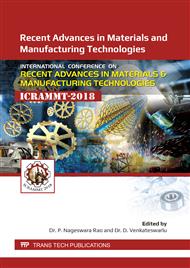[1]
F. Carpi, G. Gallone, F. Galantini, D. De Rossi, Silicone-poly(hexylthiophene) blends as elastomers with enhanced electromechanical transduction properties, Adv. Funct. Mater. 18 (2008) 235–241.
DOI: 10.1002/adfm.200700757
Google Scholar
[2]
R. Pelrine, R. Kornbluh, J. Joseph, R. Heydt, Q. Pei, S. Chiba, High-field deformation of elastomeric dielectrics for actuators, Mater. Sci. Eng. C. 11 (2000) 89–100.
DOI: 10.1016/s0928-4931(00)00128-4
Google Scholar
[3]
P. Brochu, Q. Pei, Advances in dielectric elastomers for actuators and artificial muscles, Macromol. Rapid Commun. 31 (2010) 10–36.
DOI: 10.1002/marc.200900425
Google Scholar
[4]
A. Bele, M. Cazacu, G. Stiubianu, S. Vlad, Silicone-barium titanate composites with increased electromechanical sensitivity. the effects of the filler morphology, RSC Adv. 4 (2014) 58522–58529.
DOI: 10.1039/c4ra09903f
Google Scholar
[5]
G. Gallone, F. Galantini, F. Carpi, Perspectives for new dielectric elastomers with improved electromechanical actuation performance: Composites versus blends, Polym. Int. 59 (2010) 400–406.
DOI: 10.1002/pi.2765
Google Scholar
[6]
L. Zhang, P. Bass, Z.-M. Dang, Z.-Y. Cheng, Characterization of percolation behavior in conductor–dielectric 0-3 composites, J. Adv. Dielectr. 04 (2014) 1450035.
DOI: 10.1142/s2010135x14500350
Google Scholar
[7]
L. Zhang, P. Bass, Z.-Y. Cheng, Physical aspects of 0-3 dielectric composites, J. Adv. Dielectr. 05 (2015) 1550012.
Google Scholar
[8]
L.J. Romasanta, M.A. Lopez-Manchado, R. Verdejo, Increasing the performance of dielectric elastomer actuators: A review from the materials perspective, Prog. Polym. Sci. 51 (2015) 188–211.
DOI: 10.1016/j.progpolymsci.2015.08.002
Google Scholar
[9]
L. Zhang, P. Bass, Z.Y. Cheng, Revisiting the percolation phenomena in dielectric composites with conducting fillers, Appl. Phys. Lett. 105 (2014) 042905.
DOI: 10.1063/1.4892000
Google Scholar
[10]
B. Hilczer, J. Kułek, E. Markiewicz, M. Kosec, B. Malič, Dielectric relaxation in ferroelectric PZT-PVDF nanocomposites, J. Non. Cryst. Solids. 305 (2002) 167–173.
DOI: 10.1016/s0022-3093(02)01103-1
Google Scholar
[11]
F.B. Madsen, A.E. Daugaard, S. Hvilsted, A.L. Skov, The Current State of Silicone-Based Dielectric Elastomer Transducers, Macromol. Rapid Commun. 37 (2016) 378–413.
DOI: 10.1002/marc.201500576
Google Scholar
[12]
N.M. Renukappa, Siddaramaiah, R.D. Sudhaker Samuel, J. Sundara Rajan, J.H. Lee, Dielectric properties of carbon black: SBR composites, J. Mater. Sci. Mater. Electron. 20 (2009) 648–656.
DOI: 10.1007/s10854-008-9780-4
Google Scholar
[13]
P. Ghosh, A. Chakrabarti, Conducting carbon black filled EVA vulcanizates: Assessment of dependence of physical and mechanical properties and conducting character on variation of filler loading, J. Polym. Mater. 17 (2000) 291–304.
DOI: 10.1016/s0014-3057(99)00157-3
Google Scholar
[14]
Z.M. Dang, J.K. Yuan, J.W. Zha, T. Zhou, S.T. Li, G.H. Hu, Fundamentals, processes and applications of high-permittivity polymer-matrix composites, Prog. Mater. Sci. 57 (2012) 660–723.
DOI: 10.1016/j.pmatsci.2011.08.001
Google Scholar
[15]
L. ZHANG, Z.-Y. CHENG, Development of Polymer-Based 0–3 Composites With High Dielectric Constant, J. Adv. Dielectr. 01 (2011) 389–406.
DOI: 10.1142/s2010135x11000574
Google Scholar
[16]
Y.J. Li, M. Xu, J.Q. Feng, Z.M. Dang, Dielectric behavior of a metal-polymer composite with low percolation threshold, Appl. Phys. Lett. 89 (2006) 072902.
DOI: 10.1063/1.2337157
Google Scholar
[17]
C. Brosseau, F. Boulic, P. Queffelec, C. Bourbigot, Y. Le Mest, J. Loaec, Dielectric and microstructure properties of polymer carbon black composites, J. Appl. Phys. 81 (1997) 882–891.
DOI: 10.1063/1.364173
Google Scholar
[18]
B.P. Sahoo, K. Naskar, D.K. Tripathy, Conductive carbon black-filled ethylene acrylic elastomer vulcanizates: Physico-mechanical, thermal, and electrical properties, J. Mater. Sci. 47 (2012) 2421–2433.
DOI: 10.1007/s10853-011-6065-8
Google Scholar
[19]
H.H. Hassan, G.M. Nasr, M.A. El-Waily, Electrical and mechanical properties of aluminum-loaded NBR composites, J. Elastomers Plast. 45 (2013) 121–141.
DOI: 10.1177/0095244312462160
Google Scholar
[20]
J. Saji, A. Khare, S.P. Mahapatra, Relaxation behavior of nanographite-reinforced silicon elastomer nanocomposites, High Perform. Polym. 28 (2016) 3–13.
DOI: 10.1177/0954008314568729
Google Scholar
[21]
D. Khastgir, Electric , Dielectric , and Dynamic Mechanical Behavior of Carbon Black / Styrene – Butadiene – Styrene Composites, J. Polym. Sci. Part B Polym. Phys. 41 (2003) 2983–2997.
DOI: 10.1002/polb.10627
Google Scholar
[22]
H. Zhao, D.R. Wang, J.W. Zha, J. Zhao, Z.M. Dang, Increased electroaction through a molecular flexibility tuning process in TiO2-polydimethylsilicone nanocomposites, J. Mater. Chem. A. 1 (2013) 3140–3145.
DOI: 10.1039/c2ta01026g
Google Scholar


